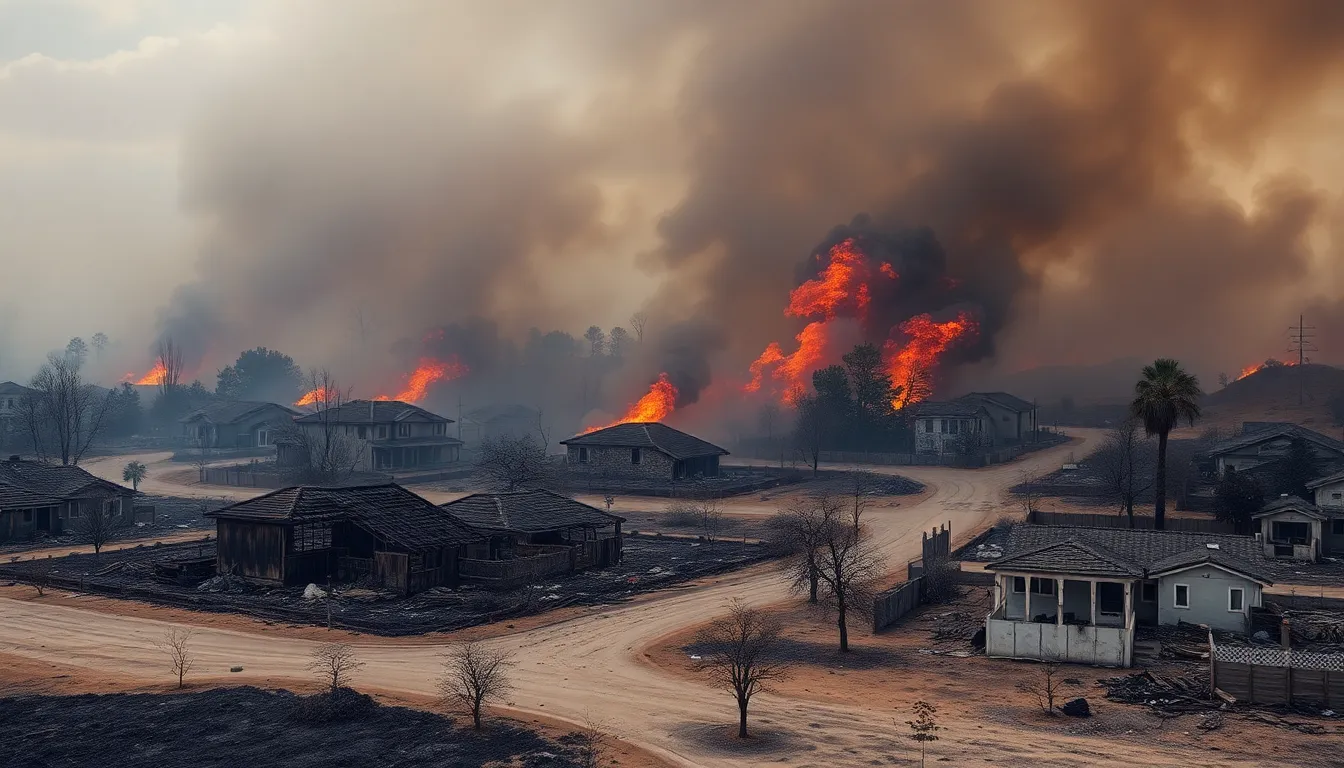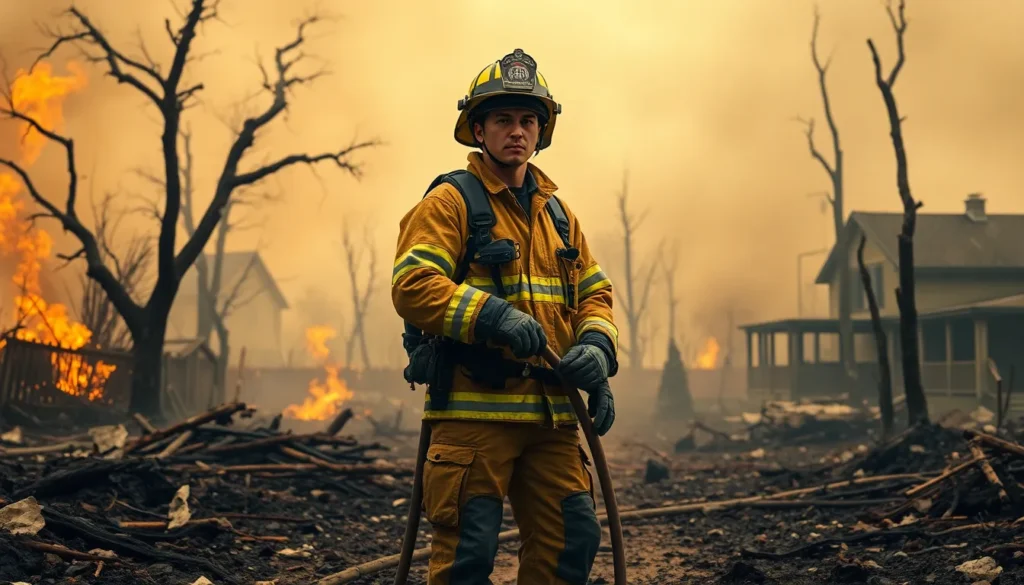In the sun-soaked sprawl of Los Angeles, where dreams often go up in smoke—sometimes quite literally—the question of how many houses burned in recent wildfires is more pressing than ever. Picture this: palm trees swaying, celebrities strutting, and then—whoosh! Flames dance across the hills, leaving homeowners scrambling for their prized possessions and their beloved avocado toast.
As fire season rages on, understanding the scale of destruction is crucial. It’s not just about statistics; it’s about lives changed, neighborhoods transformed, and the resilience of a city that refuses to be defined by its challenges. So grab your fire extinguisher and settle in as we explore the fiery details of LA’s latest battle with nature.
Table of Contents
ToggleOverview of Recent Fires in LA
Recent wildfires in Los Angeles have caused significant destruction, leaving thousands of homes at risk. In 2023 alone, fires burned approximately 20,000 acres, leading to the loss of more than 1,000 structures, including residences. First responders worked tirelessly to combat these blazes, showcasing the city’s commitment to protecting its communities.
The most notable incidents include the 2023 Getty Fire and the Dora Fire, which together devastated large swathes of land and numerous homes. As flames engulfed properties, residents faced evacuation orders, emphasizing the urgent need for effective fire management strategies. Data suggests that early intervention plays a crucial role in minimizing collateral damage during wildfire events.
Communities affected by these fires exhibited remarkable resilience and unity. Many residents banded together, providing support for evacuees and assisting firefighting efforts. Relief organizations have mobilized, collecting donations and offering resources to those impacted.
Moving forward, understanding the patterns of these wildfires becomes essential. Historical data indicates that dry conditions combined with strong winds significantly increase wildfire risks in the region. Authorities and meteorologists continue to monitor these factors, aiming to improve response times and preventive measures.
Monitoring technological advancements in firefighting and early warning systems also remains a priority. Increased investment in improved infrastructure can significantly enhance the city’s ability to combat future wildfire outbreaks. While challenges persist, the lessons learned from recent fires aid in shaping a more resilient Los Angeles.
Impact of Wildfires on Residential Areas

Wildfires dramatically impact residential areas, resulting in significant loss and destruction. In 2023, over 1,000 structures, including homes in Los Angeles, succumbed to the flames.
Statistics on Houses Burned
Approximately 20,000 acres burned due to recent wildfires. The loss of homes devastates families, leaving many displaced. The Getty Fire and the Dora Fire marked desperate moments, prompting evacuations and dangerous conditions. Community resources faced immense strain as local shelters quickly filled. Data indicates that these figures may rise if preventive measures don’t improve.
Comparison of Past Fires
Comparing recent fires to historical incidents reveals alarming trends. The frequency of devastating wildfires surged in California over the past decade. Past fires, such as the 2018 Woolsey Fire, destroyed nearly 1,500 structures, highlighting an increasing threat to residential safety. Furthermore, dry conditions and strong winds consistently compound fire risks in the region. Evaluating historical data emphasizes the necessity for enhanced fire management and community preparedness.
Community Response to Fires
Recent wildfires in Los Angeles prompted swift and robust community responses. Residents actively sought ways to help those affected.
Emergency Services Involvement
Firefighters from multiple agencies united to combat the flames, working tirelessly under challenging conditions. First responders included both local fire departments and state resources, ensuring ample support during critical moments. Rapid response times were prioritized to minimize damage and protect lives. Coordination among emergency services enhanced overall effectiveness, enabling quicker evacuations and safety measures. Continuous communication between agencies ensured that critical information reached the public promptly.
Community Support Initiatives
Local organizations quickly mobilized to provide aid for displaced individuals and families. Food drives and donation centers served as lifelines, offering essential supplies to those impacted. Volunteers stepped up, assisting with possessions recovery efforts and providing emotional support to evacuees. Community meetings facilitated information sharing, allowing residents to connect and strategize on recovery efforts. These initiatives showcased the strength and solidarity of Los Angeles, emphasizing the commitment of its residents to support one another during difficult times.
Long-Term Effects on Housing Market
Wildfires in Los Angeles significantly influence the housing market. Over 1,000 structures lost amidst the flames create a notable decline in available homes. Areas impacted by the recent fires face heightened uncertainty regarding property values. Buyers often hesitate when considering homes in regions prone to wildfires, fearing future risks.
Rebuilding efforts may take years, affecting both supply and demand dynamics. Limited availability of homes can result from extensive damage, leading to increased prices in unaffected neighborhoods. Homeowners may find it difficult to sell properties in fire-prone areas due to lingering concerns about safety. Consequently, insurance rates may rise as carriers reevaluate risk exposure associated with these regions.
Demographics also shift as displaced families seek housing elsewhere. Increased demand for rentals occurs in nearby cities as residents abandon burned neighborhoods. Furthermore, shifts in population can strain the housing market in adjacent areas, driving prices higher. Long-term, this displacement can cause economic shifts affecting local businesses and services.
Policy changes may emerge as local governments adapt to the realities of climate change impacts. Enhanced building codes and land use regulations can influence future development, focusing on fire-resistant construction techniques. Increased collaboration among local authorities, builders, and insurers aims to create safer living environments.
Historical patterns indicate a growing frequency of wildfires in California, thereby compelling residents to reconsider where they live. Evaluating the long-term effects on the housing market requires a close look at these evolving dynamics. Understanding these trends equips policymakers and buyers alike to engage with an increasingly complex real estate landscape.
Preventative Measures for Future Fires
Understanding effective preventative measures will minimize the risks of future wildfires. Local authorities prioritize vegetation management to reduce fire fuel in high-risk areas. Implementing controlled burns helps manage underbrush, lessening the chance of larger blazes.
Community education programs educate residents about fire risks. Residents learn about creating defensible spaces around properties by clearing flammable materials. Engaging homeowners in workshops fosters interest in fire safety practices.
Technological advancements play a vital role in fire detection and response. Enhanced early warning systems provide timely alerts to residents and first responders. Drones and satellite imagery offer accurate monitoring of wildfire progression, allowing for more efficient resource allocation.
Building codes undergo revisions to enhance fire safety in residential areas. Construction materials increasingly include fire-resistant options that withstand high temperatures. Stricter regulations for property development in wildfire-prone regions focus on minimizing structural vulnerabilities.
Collaboration among governmental agencies strengthens fire management strategies. Regular joint training exercises for firefighters improve coordinated response efforts during emergencies. Unified command systems streamline communication, enhancing overall effectiveness during wildfire events.
Public awareness campaigns highlight the significance of reporting suspicious activities. Proactive community involvement leads to quicker identification of potential arson threats. Local partnerships facilitate information sharing, ensuring everyone remains informed about ongoing fire safety measures.
Adopting sustainable landscaping practices contributes positively to fire prevention. Native plants with lower flammability are encouraged in residential gardens. These techniques not only beautify neighborhoods but also enhance overall safety and decrease fire hazards.
Investments in fire response infrastructure improve capabilities to combat future wildfires. Upgraded firefighting equipment ensures that responders have the necessary tools to manage flames effectively. Continued focus on preventative strategies builds a safer environment for all residents in Los Angeles.
Conclusion
The wildfires in Los Angeles have left a lasting impact on the community and its housing landscape. With over 1,000 homes lost and thousands of acres scorched, the urgency for improved fire management and community preparedness has never been clearer. The resilience shown by residents and first responders highlights the strength of the city in the face of adversity.
As Los Angeles navigates the aftermath, the focus shifts to long-term solutions that enhance safety and mitigate future risks. Understanding the evolving dynamics of the housing market and implementing effective preventative measures will be vital. The lessons learned from these devastating events will guide the city’s efforts to build a more resilient future for all its residents.




